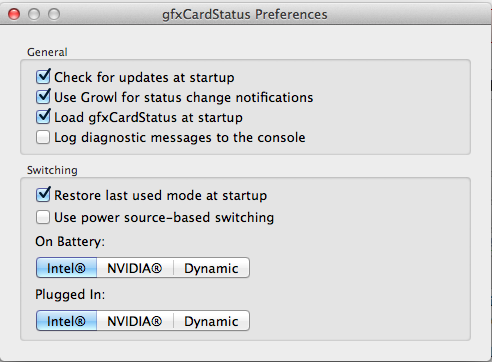

- #Gfxcardstatus 2.44i for mac os x
- #Gfxcardstatus 2.44i mac os x
- #Gfxcardstatus 2.44i install
- #Gfxcardstatus 2.44i upgrade
#Gfxcardstatus 2.44i upgrade
It also helps if you're upgrading your system or want to upgrade one card to another.
#Gfxcardstatus 2.44i install
The setup is quite simple: just download the gfxcardstatus, install it and then let it run to identify which graphics card is running. You can select from multiple options on the software menu to display the different cards that are running, such as integrated-only mode, desktop mode, or discrete mode. The main difference between the two is that, in integrated-only mode, the status only lists the name of the card, while in desktop mode, it displays the manufacturer, model, card type, RAM, and frequencies. Also, in the discrete mode, the application can display up to 16 active monitors, whereas in the integrated-only mode only the monitor list is displayed.
#Gfxcardstatus 2.44i mac os x
The benefits of this utility are pretty clear: if you're using an older Mac OS X, such as Leopard, and you're going to upgrade to a newer Mac OS X (such as Mountain Lion), having this utility to compare your cards will save you some time and hassle. This is especially helpful if you've just installed a new integrated graphics card or dual core processor.
#Gfxcardstatus 2.44i for mac os x
As you can see, with the simple installation process, this utility is very useful for Mac OS X users who need to make frequent changes to their active gpu or discrete card. With just a few clicks, you can compare your available options, identify the best option based on your needs, and run the necessary action to complete the process. So even if you're running a more mature integrated graphics card and dual core processor in your Macbook Pro, it's still possible to keep track of the speed and temperature of your card. And if you're planning to buy a new Macbook Pro later down the line, this tool is definitely a must have feature for you to be able to fully utilize your Macbook Pro when it comes out of the box.Hello all.

Long story short, my 2011 macbook pro has the dreaded logic board issue. Whenever an app needs the discrete video card, it will reboot. I have to reset the pram, smc, try to go into internet recovery mode, etc. They won't repair it because it's vintage. They referred me to an authorized repair center but $ is tight, so I'm looking for alternatives. It's a great computer and runs fine when it's up. I downloaded gfxcardstatus 2.4.4i (running High Sierra 10.3.3) and set it to use integrated only. It was my understanding that it should force any app to use the integrated gpu but apps that need the discrete gpu are still using it, like Chrome and Photos. Just wondering if anyone had any experience with the app and if I'm doing something wrong? Or will it not force apps that are designed to use the discrete gpu to use the integrated gpu? Perhaps my only way around this is to not use those apps and find alternatives. Mac Pro (mid 2010) graphics cards keep failing I have a Mac Pro (mid 2010) that I have bought new in 2012. It does everything I want and has more power that I need.Įarlier this year the graphics card finally gave up the ghost and failed. Worse yet (the repairman told me) it shunted the power to some board in my beloved Mac Pro and burned that out. So I had him install a new graphics card (Nvidia Quadro) and replace the burned out board.Īfter about five months I would randomly find the Mac Pro shut down, and sometimes the UPS would be beeping. The UPS manufacturer support article said that this occurs when something in the computer gets too hot. Odd that this only happened when it had been in sleep mode and always sometime during the night. This would only occur every few weeks.įinally in November I got weird squiggles on the screen. I called a repair guy and he said that it was the graphics card failing.


 0 kommentar(er)
0 kommentar(er)
